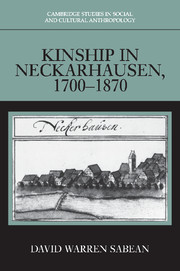Book contents
- Frontmatter
- Contents
- List of tables
- Abbreviations
- Abbreviations of sources
- On reading kinship diagrams
- Glossary
- Preface
- Introduction
- Cohort I (1700–1709)
- Cohort II (1740–1749)
- Cohort III (1780–1789)
- Cohort IV (1820–1829)
- Cohort V (1860–1869)
- Conclusion
- 20 Neckarhausen in European comparative perspective
- 21 Consanguinity in modern Europe
- 22 Kinship and class formation
- 23 Kinship and gender
- Appendix
- Bibliography
- General index
- Index of villagers
22 - Kinship and class formation
Published online by Cambridge University Press: 04 August 2010
- Frontmatter
- Contents
- List of tables
- Abbreviations
- Abbreviations of sources
- On reading kinship diagrams
- Glossary
- Preface
- Introduction
- Cohort I (1700–1709)
- Cohort II (1740–1749)
- Cohort III (1780–1789)
- Cohort IV (1820–1829)
- Cohort V (1860–1869)
- Conclusion
- 20 Neckarhausen in European comparative perspective
- 21 Consanguinity in modern Europe
- 22 Kinship and class formation
- 23 Kinship and gender
- Appendix
- Bibliography
- General index
- Index of villagers
Summary
From the preceding chapters it is clear that Neckarhausen and other rural areas experienced a reconfiguration of kinship as an endogamous alliance system, and that this transformation was closely connected with the articulation and systematic integration of classes. If the rise of a new alliance system was a general phenomenon in Europe toward the end of the eighteenth century – as I have argued in Chapter 21 – then that kinship was probably tied up in some fashion with the formation of classes throughout the society. In Delille's view, endogamy in the rural region around Naples was initiated by a rural bourgeoisie whose social relations were determined by fluid forms of wealth. He is quite right to suggest that kinship and class had a great deal to do with each other, but the phenomenon needs to be investigated more as part of an encompassing shift to modernity than as a pathology.
Delille's work is subtle and challenging, one of the most important studies of kinship in a European context. However, he has looked at the relationships back to front. Class differentiation and capitalist social relations, in his schema, produce, or at least are the foundation for, innovative patterns of familial alliance. And although this correlation is compelling, I believe that kinship was not a dependent variable but an active factor in constructing class-based networks and providing essential class experience.
- Type
- Chapter
- Information
- Kinship in Neckarhausen, 1700–1870 , pp. 449 - 489Publisher: Cambridge University PressPrint publication year: 1997



